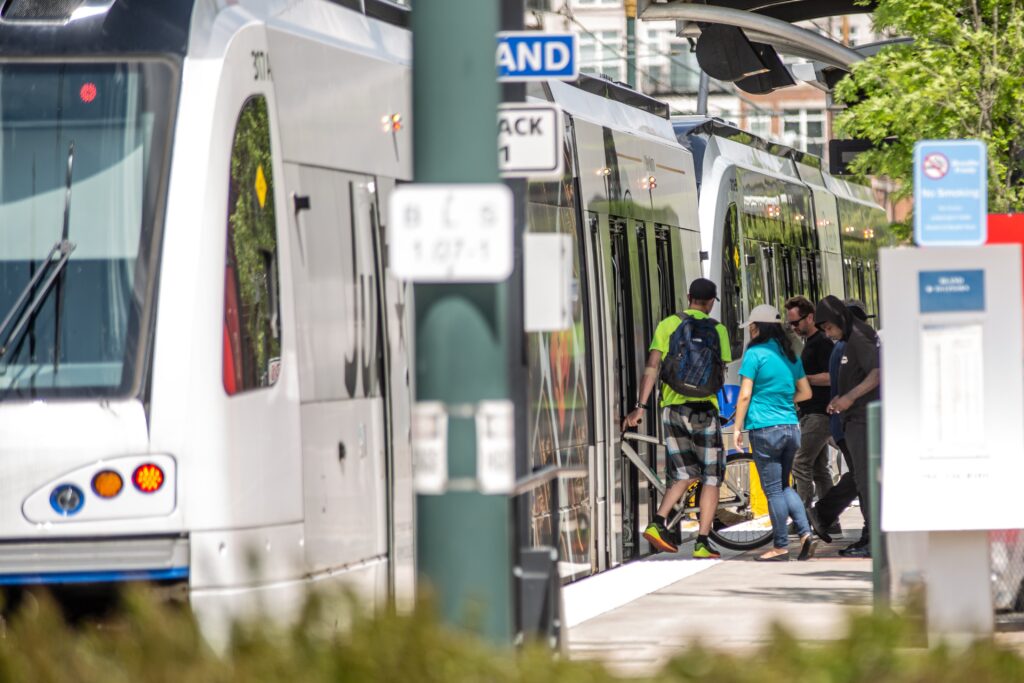Charlotte’s mobility needs vastly outweigh available funding
This month’s Transportation, Planning, and Development Committee meeting on Monday, April 3rd was chock full of information. Three items were on the agenda: a mobility update from Centralina Regional Council’s executive director Geraldine Gardner, a CATS update from interim CEO Brent Cagle and County Manager Marcus Jones, and proposed UDO text amendments presented by interim director for Planning, Design & Development, Alyson Craig. You can view the agenda and accompanying slides here.
by Hope Wright, Advocacy Manager
This blog post covers the mobility update portion of the meeting. For a recap of the CATS update and UDO text amendments covered later in the committee meeting, please see this blog post.

Charlotte’s transportation network needs to grow! (Image: City of Charlotte)
Mobility update
City manager Marcus Jones kicked off the discussion by clarifying that mobility planning has two scales: big “R” Regional and little “r” regional. Big “R” Regional goes beyond Mecklenburg County and little “r” regional encompasses Charlotte and Mecklenburg County including the extra-territorial jurisdictions. This update focused on mobility in the little “r” category.
Gardner then walked committee members through Connect Beyond’s five mobility moves, each with several sub-recommendations. Connect Beyond is a regional transit plan for residents and visitors spanning two states (NC and SC) and 12 counties. She indicated that Connect Beyond is focused on building upon and stitching together local plans, not just Charlotte plans, and recognized the need to advance the implementation of these plans to ensure that the region is competitive for federal funding.
However, both Gardner and Jones highlighted the complex landscape of local stakeholders and the challenges they pose to coordinating regional implementation. Several solutions were presented, including assembling a think tank type group called “Advancing the Plan Committee” made up of business alliances and decision makers. This committee would be charged with advocating for local funding and supporting local initiatives both within and outside Charlotte.
Jones then briefly presented two booklets to the committee. One had the full list of 2,002 mobility projects currently identified in Charlotte, and the other, referred to as the Blueprint, outlined five mega projects that cover several mobility projects each. These mega projects would strategically combine projects in each of the seven districts to “unleash capacity” without requiring a new funding source. The funding would come from the CIP budget, which has $210 million scheduled for each bond cycle in 2024, 2026, and 2028. Unfortunately, this would only cover the cost of updating two streets and two intersections.
City Council Member (CM) Malcolm Graham thanked Gardner and Jones for their work, but doesn’t feel or see enough momentum on mobility. CM Renee Johnson brought up the need to build trust and realistic expectations with the towns of northern Mecklenburg County, who are currently not united in support of the proposed mobility plan. Jones and Gardner indicated that there are regular meetings happening between city/town managers, but acknowledged the need for more elected officials within Mecklenburg County to engage with each other and speak about the promise of Connect Beyond.
Committee Chair Ed Driggs wrapped the discussion by stating that legislators in Raleigh have a different perspective on mobility than Mecklenburg County. This means that a referendum for a one-cent tax is highly unlikely in 2023. None of the committee members disagreed.
Our take
While we are pleased that planning for regional mobility is continuing, we were discouraged to hear that the one-cent for mobility sales tax has been tabled for yet another year. As Jones pointed out, only specific projects that fall within the 5 mega projects can be completed in the next 5 years using the existing CIP budget and resulting bond cycles. Given the Charlotte area’s large and growing population, this is simply not enough to meet the mobility needs of our current and future residents.
We need a dedicated funding source to make these ambitious mobility plans a reality. What is the plan for securing this necessary funding? And what is the timeline? Sustain Charlotte will continue to make the one-cent for mobility sales tax a priority in our advocacy, but we will also need decision makers to unify and make the case in Raleigh.
